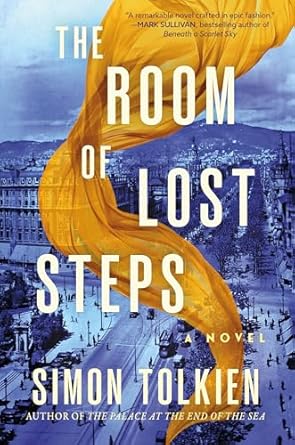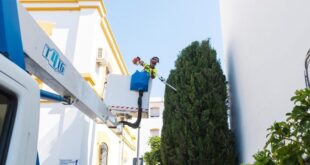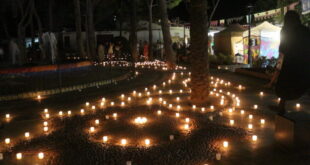This month, the grandson of Lord of the Rings writer JRR Tolkien released a new historical adventure set at the beginning of the Spanish Civil War.
‘The Palace at the End of the Sea’ by Simon Tolkien, is a coming-of-age novel following Theo, a young man who travelled across continents from New York in the midst of the Great Depression to Spain, a country teetering on the edge of an internal war. It is a combination of fiction with real history both in terms of time and location.
Simon, an ex-criminal barrister from the UK who is now a novelist, spent the past decade in Santa Barbara, California. He says that the town is heavily influenced from Spain’s traditional Pueblos.
READ MORE Bomb squad is called in Spain after local finds live grenade from the Spanish Civil War
After writing ‘No Man’s Land’ set during the first World War, and before that, ‘Orders from Berlin’ set during the 1940s London Blitz, Simon says he wanted to tell a story set in between those time periods. He settled on the 1930s. A period of ‘illusion and disillusion’, themes which carry through this book.
“From a novelist’s perspective, the experience of war by people is very interesting.” He says. Simon kept the story of the International Brigade in the back of his mind. Specifically, the United States Lincoln Battalion, who fought from January 1937 until November 1938, on the forefront of his thoughts.

He says, “I thought their story was really amazing.” “Where they were from, that they would’ve travelled all the way around the world to fight in an overseas war out of ideological reasons and to experience such sacrifice,” he said.
The Lincoln Battalion consisted of American volunteers, many of whom were communists. They fought against General Francisco Franco’s Nationalist forces in Spain.
In total, around 2,800 men were part of the Internal Brigade. This group was composed of 40,000 men and woman from 52 nations who fought in the Spanish Civil War. Nine hundred soldiers from the Lincoln Battalion lost their lives in action.
Simon drew inspiration from the diaries of many who wrote during their stay in Spain.
Theo is the main character and speaks Spanish fluently. He is the son an American businessman, and a Mexican Refugee. He finishes his education in the United Kingdom and finds himself in an Andalucian village in the early 1930s, at the foothills the Sierra Nevada.
Simon says, “I thought that coming of age was helpful because the hero would discover things the same as the reader.” This became especially important when he arrived in Spain.
He wanted Theo’s participation in the Spanish Civil War to be more than just a pure ideological motivation. Theo has a Spanish background and is immersed in Spain. The majority of Republicans who fought during the civil war in Spain were farm workers.
Simon says, “Theo falls in love not only with Spain but also with a Spanish woman.” “And he now has a more extensive and interesting stake in the conflict.”
Simon never visited Andalucia but he was inspired by writers who had. He wanted to make sure that his book accurately depicted the south of Spain in 1930. He gained specific insight from Gerald Brenan’s autobiographical ‘South from Granda.’ Brenan moved to Spain in 1920.


Simon says, “He was born and raised in the small village of Yegen, Andalucia. He had mastered the art of bringing it to life.” Brenan did not just tell me the economic and social background, but also showed me first-hand what he saw and experienced.
Simon explains that the extreme rich-poor division and the spread of anarchism in Southern Spain’s Pueblos were a major influence on Theo’s character development. Theo is convinced that as he begins to realize who he really is and what he stands for, he will be able to fight fascism in order to change the entire world.
“Many people Theo meets, in particular the vaqueros, who work the land, don’t own anything.” Simon says that they own nothing, and are left to practically starve for half the year because their need on the land is only seasonal.
Trying to wrap his head around the ‘extraordinary complexity of Spanish politics’ was one of the biggest challenges of writing the book for Simon. Simon says the landscape was extremely challenging because of the shifting alliances, people’s motives, and involvement by foreign powers. It was intimidating at first, but exciting because people hadn’t done this before.
The Spanish Civil War was covered extensively by Spanish and English historians. However, since Hemingway’s time there has not been much historical fiction set in this period.
Simon claims that the book, which explores wealth disparities, totalitarianism and democracy, as well as the subversions of democracy, has parallels to the war currently raging in Ukraine. He says that the question is what foreign powers who are concerned about morality do when their sovereignties are invaded. Whether or not their economic interests are compatible with intervening.
Simon’s first book was intended to be an independent work. “But it became an account of the 1930s across three countries,” says Simon. “So it obviously grew in size.”
The book had to be divided in two. Theo ends the first book in Barcelona. As the civil war breaks out. The sequel ‘The Room of Lost Steps’ will be released in September.


READ MORE British artist creates graphic novel inspired by grandparents’ role during the Spanish Civil War
The Olive Press Travel News is available here.
 Costa News Spain Breaking News | English News in Spain.
Costa News Spain Breaking News | English News in Spain.





